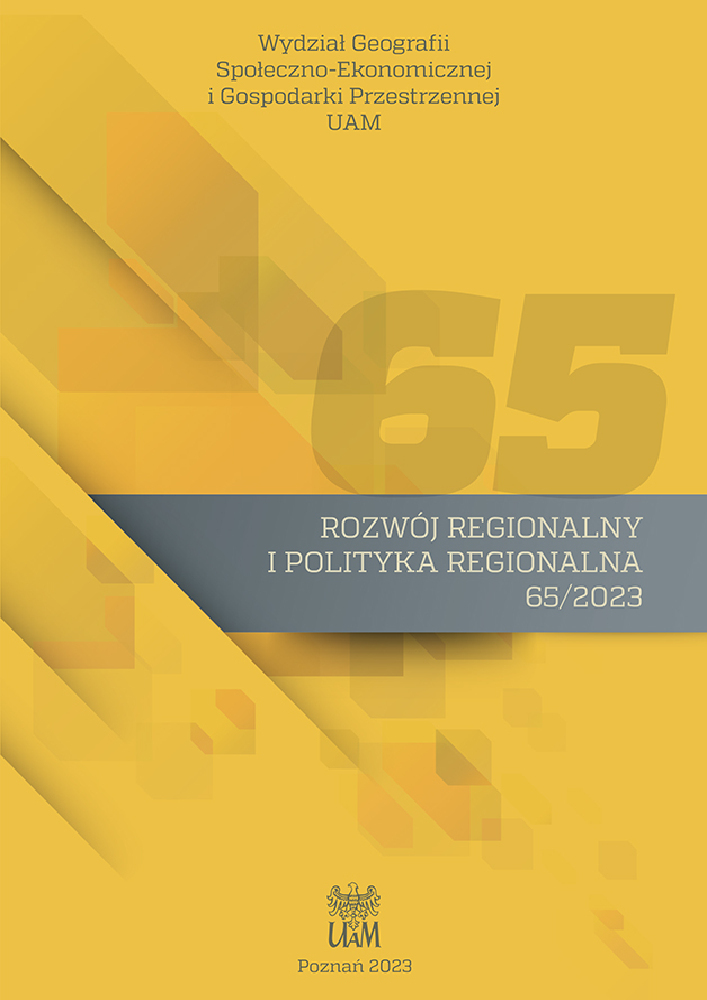Abstract
The development of the service sector, which is observed along with the increase in socio-economic development, is only one of the symptoms of changes in the economy. Much more important are the changes in the structure of the service sector itself. Due to the high heterogeneity of this sector, only a detailed analysis of changes to individual types of services gives a complete picture of the changes and the importance of the third sector in the economy.
The article’s main objective is to identify changes taking place in the structure of the EU countries’ services sector using the transfer method of share transfer. The analysis was carried out in the format of NACE sections (PKD) in 2010–2020 for the number of economic entities and employees in the territorial layout at the NUTS2 level.
The analysis concludes that there is a decline in the importance of traditional services under Section G, the development of professional, scientific and technical services (Section M) and an increase in the importance of ICT-related services (Section J). Polish regions do not differ from the panuropean pattern of change; some belonged to units with the most dynamically developing sections of the surveyed services in Europe.
References
Dominiak J. 2019. Nowoczesne usługi w ujęciu przestrzennym i ich rola w rozwoju społeczno-gospodarczym. Bogucki Wydawnictwo Naukowe, Poznań.
Dominiak J., Hauke J. 2015. The changes of the services sector in Poland and other UE countries. Studia Regionalia, 41-42: 37-50.
Dominiak J., Rachwał T. 2016. Chief development tendencies, structural changes and innovativeness of the industrial and services sectors in Poland. Quaestiones Geographicae, 35, 4: 49-69. DOI: https://doi.org/10.1515/quageo-2016-0034
Duernecker G., Sanchez-Martinez M. 2021. Structural change and productivity growth in Europe: Past, present and future. JRC Working Papers on Territorial Modelling and Analysis, 09. European Commission, Seville, JRC126447. DOI: https://doi.org/10.2139/ssrn.3932032
Dunn E.S. 1960. A statistical and analytical technique for regional analysis. Papers and Proceedings of the Regional Science Association, 6: 97-112. DOI: https://doi.org/10.1111/j.1435-5597.1960.tb01705.x
Flejterski S., Panasiuk A., Perenc J., Rosa G. (red.) 2005. Współczesna ekonomika usług. Wydawnictwo Naukowe PWN, Warszawa.
Jorgenson D.W., Timmer M.P. 2011. Structural Change in Advanced Nations: A New Set of Stylised Facts. The Scandinavian Journal of Economics, 113(1): 1-29 (http://www.jstor.org/stable/23016820). DOI: https://doi.org/10.1111/j.1467-9442.2010.01637.x
Kłosowski F. 2006 Sektor usług w gospodarce regionu tradycyjnego w warunkach transformacji i restrukturyzacji. Przykład konurbacji katowickiej. Wydawnictwo Uniwersytetu Śląskiego, Katowice.
Lawless M., Rehill L. 2021. Market Power, Productivity and Sectoral Labour Shares in Europe. Open Economic Review, 33: 453-476 DOI: https://doi.org/10.1007/s11079-021-09653-3
Lewandowska-Gwarda K., Antczak E. 2015. Analysis of internal emigration in Poland using the spatial dynamic shift-share method. Argumenta Oeconomica, 2, 35: 123-143. DOI: https://doi.org/10.15611/aoe.2015.2.07
Łaźniewska E., Górecki T. 2008. Rozwój gospodarczy polskich regionów na podstawie analizy shift-share w latach 1999–2004. Prace Naukowe Uniwersytetu Ekonomicznego we Wrocławiu, 19: 187-196.
Markowska M. 2015. Ocena zmian struktury pracujących w unijnych regionach szczebla NUTS2 z wykorzystaniem miary Braya i Curtisa. Prace Komisji Geografii Przemysłu Polskiego Towarzystwa Geograficznego, 29, 2: 7-22. DOI: https://doi.org/10.24917/20801653.292.1
Markowska M., Sokołowski A. 2019. Sektorowe struktury zatrudnienia w krajach Unii Europejskiej w latach 2008-2017 – nowe podejście w ocenie dynamiki. Prace Komisji Geografii Przemysłu Polskiego Towarzystwa Geograficznego, 33, 2: 7-17. DOI: https://doi.org/10.24917/20801653.332.1
Markowska M., Sokołowski A., Strahl D., Sobolewski M. 2015. Dynamiczna klasyfikacja regionów UE ze względu na strukturę rynku pracy – pozycja regionów polskich. Prace Komisji Geografii Przemysłu Polskiego Towarzystwa Geograficznego, 29(2): 23-36. DOI: https://doi.org/10.24917/20801653.292.2
Markowska M., Strahl D. 2020. Klasyfikacje krajów Unii Europejskiej z uwagi na struktury zatrudnienia w sektorach i wybranych sekcjach – ocena zgodności podziałów. Prace Komisji Geografii Przemysłu Polskiego Towarzystwa Geograficznego, 34(1), 7-19. DOI: https://doi.org/10.24917/20801653.341.1
Maroto-Sanchez A., Cuadrado-Roura J.R. 2011. Analyzing the role of the service sector on productivity growth across European Region. Institute of Social and Economic Analysis Working Paper, 04.
Peneder M., Kaniovski S., Dachs B. 2003. What follows tertiarisation? Structural change and the role of knowledge-based services. The Service Industries Journal, 23, 2: 47-66. DOI: https://doi.org/10.1080/02642060412331300882
Perloff H., Dunn E., Lampard R., Muth R. 1960. Regions, resources, and economic growth. Johns Hopkins University Press, Baltimore.
Sen A. 2020. Structural change within the services sector, Baumol’s cost disease, and cross-country productivity differences. MPRA Paper, 99614. University of Essex (https://mpra.ub.uni-muenchen.de/99614/).
Suchecki B. (red.) 2010. Ekonometria przestrzenna. Metody i modele analizy danych przestrzennych. Wydawnictwo C.H. Beck, Warszawa.
License
Copyright (c) 2023 Joanna Dominiak, Tomasz M. Kossowski

This work is licensed under a Creative Commons Attribution 4.0 International License.

